Increased Pathogenicity of West Nile Virus (WNV) by Glycosylation of Envelope Protein and Seroprevalence of WNV in Wild Birds in Far Eastern Russia
Abstract
:1. Introduction
2. Increased Pathogenicity of West Nile Virus by Glycosylation of Envelope Protein in Chicks
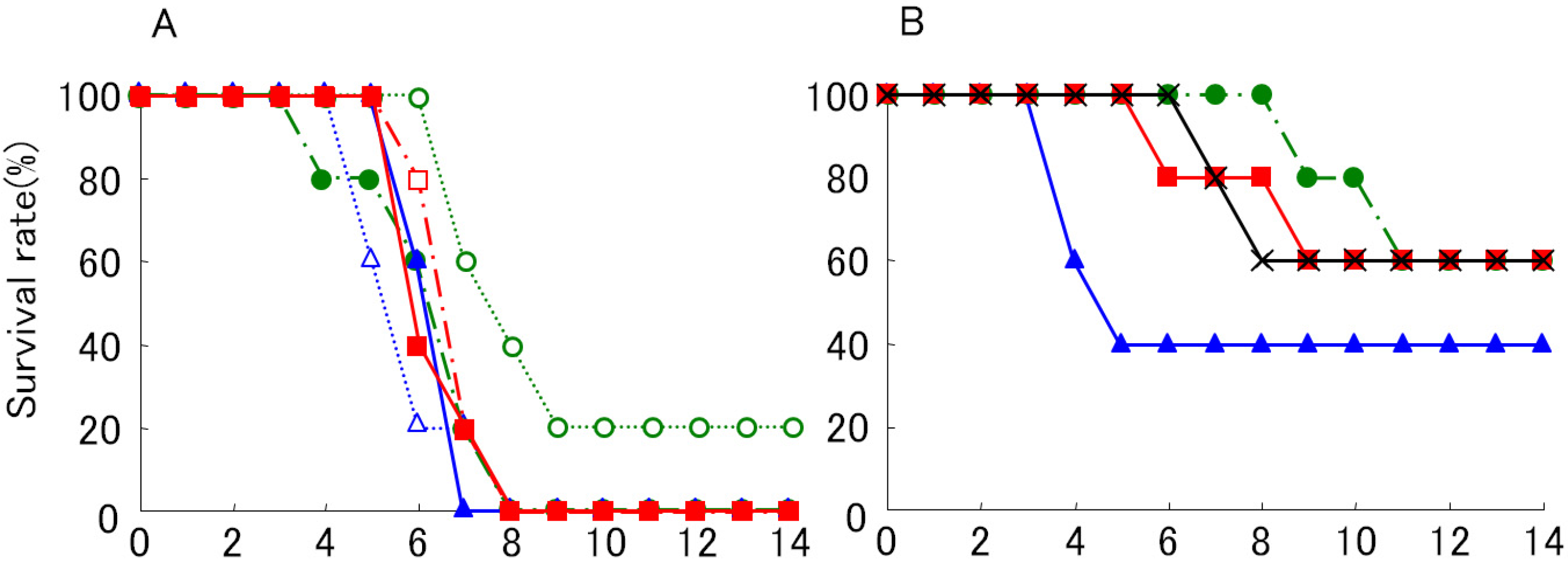

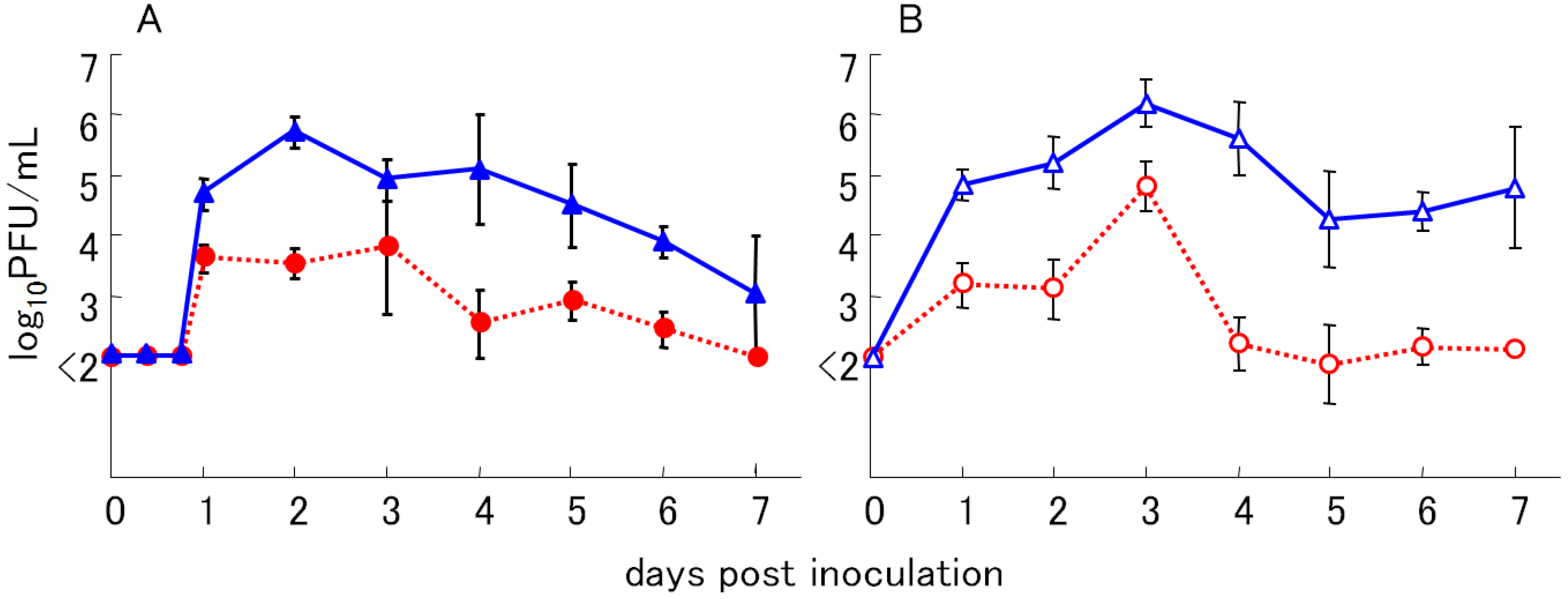
2.1. Increased Replication of Glycosylated WN Virus Variant in Vitro

| WN virus variant | Virus dose (PFU) | ||
|---|---|---|---|
| 107 | 106 | 105 | |
| 6-LP | 10/10 * | 9/9 | 5/6 |
| 6-SP | 6/6 | 11/11 | 4/10 |
2.2. Replication of WN Virus and Cytokine Responses in Infected Chicks
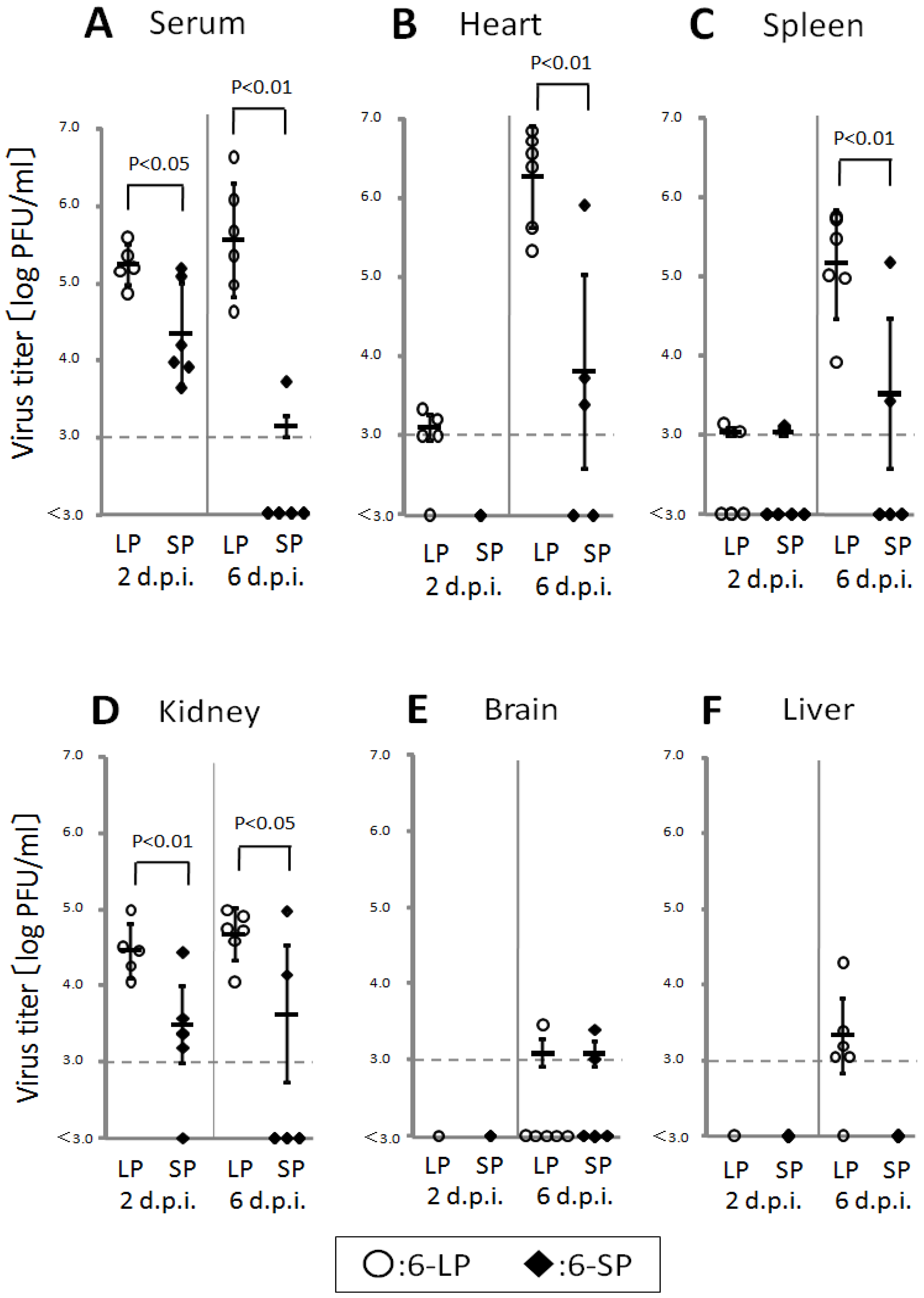
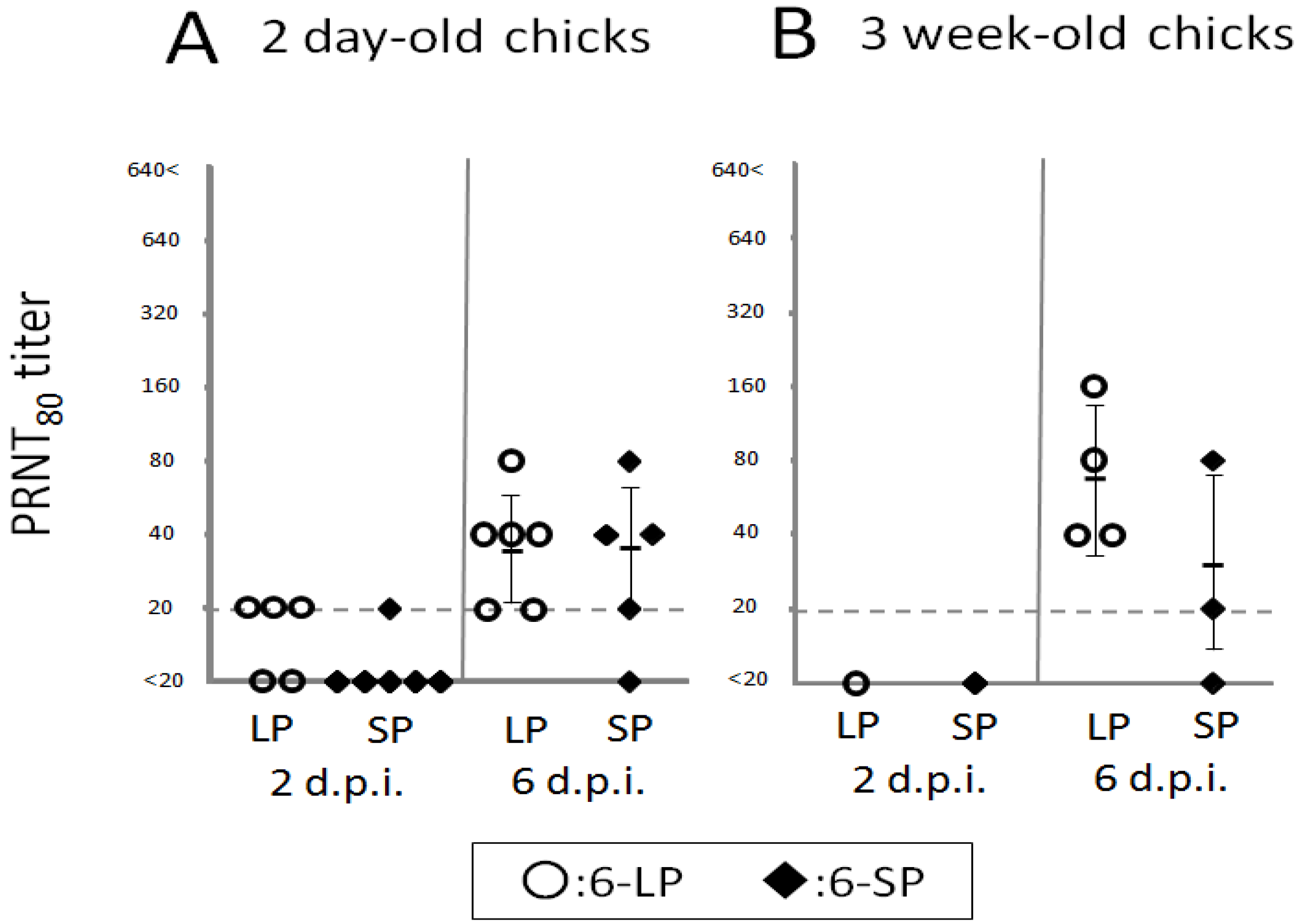
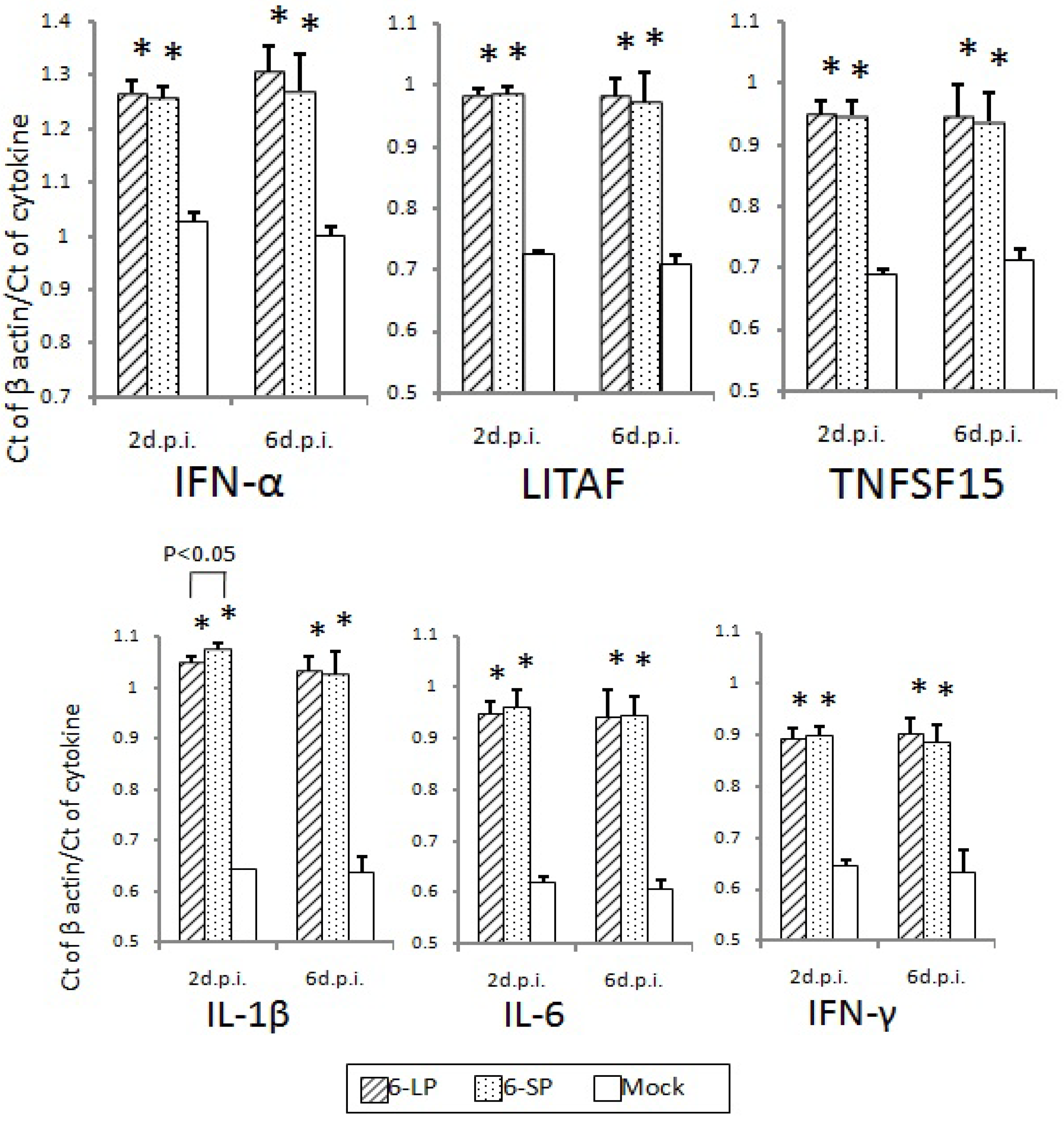
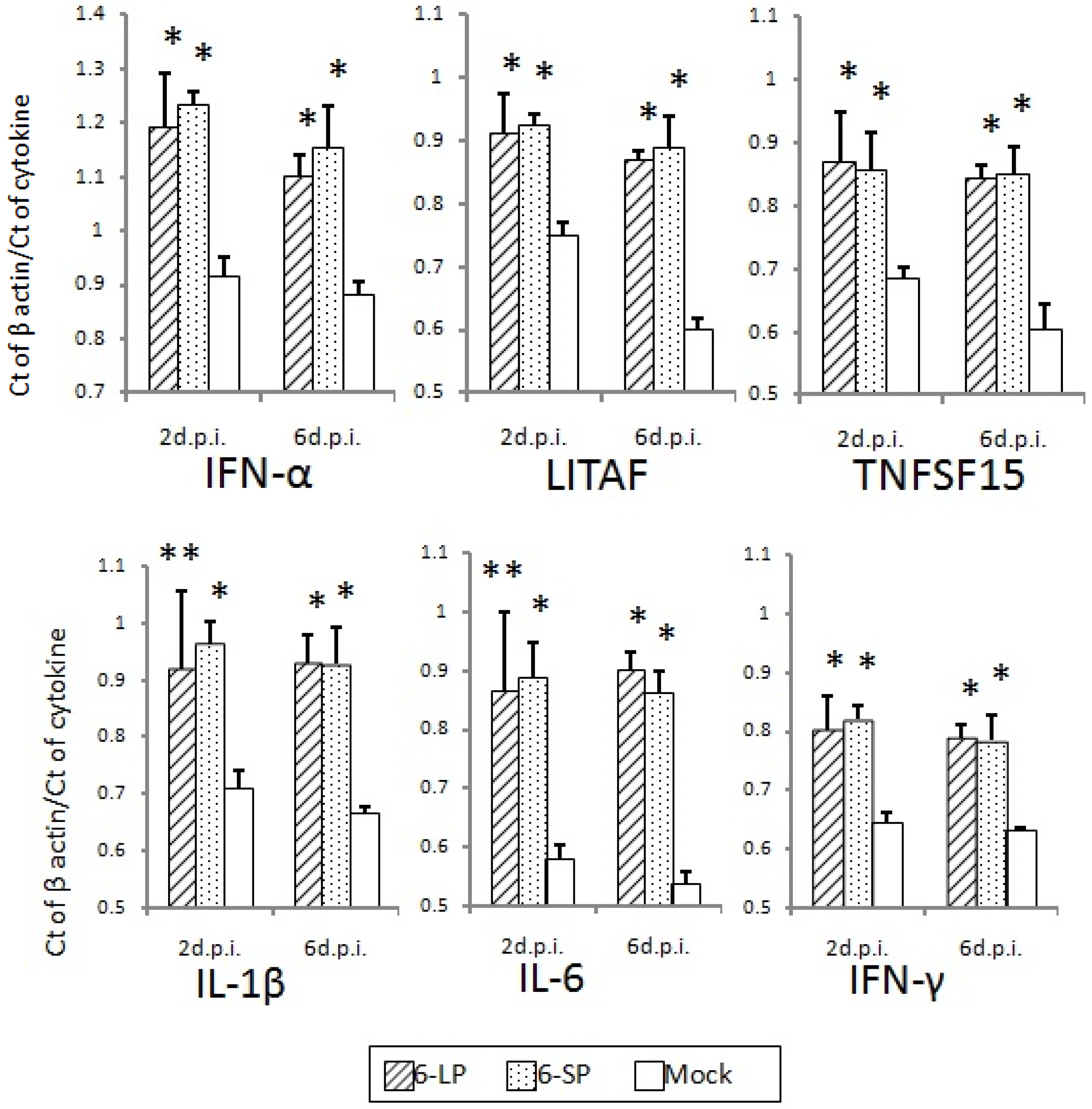

2.3. Establishment of Micro-Focus Reduction Neutralization Test to Detect Antibodies to WN Virus


3. Seroprevalence of WN Virus in Wild Birds in Far Eastern Russia
| Area/Year | Bird Species (Order) | No. of WNV-Positive/Tested Sera | Positive for Anti-WNV Antibodies % | FRNT80 Titer * Range | |
|---|---|---|---|---|---|
| WNV | JEV | ||||
| Khanka Lake/2005 | Anas poecilorhyncha (Anseriformes) | 1/1 | 100 | 160 | 40 |
| Larus ridibundus (Charadriiformes) | 1/1 | 100 | 160 | 80 | |
| Streptopelia orientalis (Columbiformes) | 1/1 | 100 | 1,280 | <40 | |
| Five other species | 0/23 | 0 | <160 | NT † | |
| Anyui River/2005 | Histrionicus histrionicus (Anseriformes) | 3/13 | 23.1 | 160–320 | 40 |
| Four other species | 0/11 | 0 | <160 | NT | |
| Khanka Lake/2006 | Anas poecilorhyncha (Anseriformes) | 1/2 | 50.0 | 160 | 40 |
| Mergus serrator (Anseriformes) | 1/8 | 12.5 | 160 | <40 | |
| Sterna hirundo (Charadriiformes) | 2/13 | 15.4 | 160–320 | 40–320 | |
| Columba livia (Columbiformes) | 1/1 | 100 | 320 | 80 | |
| Streptopelia orientalis (Columbiformes) | 4/9 | 44.4 | 1,280–2,560 | 80 | |
| Three other species | 0/8 | 0 | <160 | NT | |
| Chor River/2006 | Anas poecilorhyncha (Anseriformes) | 2/9 | 22.2 | 160 | 40–80 |
| Mergus serrator (Anseriformes) | 2/22 | 9.1 | 160–640 | 40–80 | |
| Phalacrocorax carbo (Pelecaniformes) | 2/9 | 22.2 | 160 | 40 | |
| Twelve other species | 0/14 | 0 | <160 | NT | |
| Total | 21/145 | 14.5 | <160–2,560 | <40–320 | |
4. Conclusions
Acknowledgments
Conflicts of Interest
References
- Petersen, L.R.; Roehrig, J.T. West Nile virus: A reemerging global pathogen. Emerg. Infect. Dis. 2001, 7, 611–614. [Google Scholar]
- Hamman, M.H.; Delphine, H.C.; Winston, H.P. Antigenic variation of West Nile virus in relation to geography. Amer. J. Epidemiol. 1965, 82, 40–55. [Google Scholar]
- Hubálek, Z.; Halouzka, J. West Nile fever—A reemerging mosquito-borne viral disease in Europe. Emerg. Infect. Dis. 1999, 5, 643–650. [Google Scholar] [CrossRef]
- Anderson, J.F.; Vossbrinck, C.R.; Andreadis, T.G.; Iton, A.; Beckwith, W.H., 3rd; Mayo, D.R. A phylogenetic approach to following West Nile virus in Connecticut. Proc. Natl. Acad. Sci. USA 2001, 98, 12885–12889. [Google Scholar] [CrossRef]
- Garmendia, A.E.; van Kruiningen, H.J.; French, R.A. The West Nile virus: Its recent emergence in North America. Microbes Infect. 2001, 3, 223–229. [Google Scholar] [CrossRef]
- Marfin, A.A.; Gubler, D.J. West Nile encephalitis: An emerging disease in the United States. Clin. Infect. Dis. 2001, 33, 1713–1719. [Google Scholar] [CrossRef]
- Brault, A.C.; Langevin, S.A.; Bowen, R.A.; Panella, N.A.; Biggerstaff, B.J.; Miller, B.R.; Komar, N. Differential virulence of West Nile strains for American crows. Emerg. Infect. Dis. 2004, 10, 2161–2168. [Google Scholar] [CrossRef]
- Brault, A.C.; Huang, C.Y.; Langevin, S.A.; Kinney, R.M.; Bowen, R.A.; Ramey, W.N.; Panella, N.A.; Holmes, E.C.; Powers, A.M.; Miller, B.R. A single positively selected West Nile viral mutation confers increased virogenesis in American crows. Nat. Genet. 2007, 39, 1162–1166. [Google Scholar] [CrossRef]
- Komar, N.; Langevin, S.; Hinten, S.; Nemeth, N.; Edwards, E.; Hettler, D.; Davis, B.; Bowen, R.; Bunning, M. Experimental infection of North American birds with the New York 1999 strain of West Nile virus. Emerg. Infect. Dis. 2003, 9, 311–322. [Google Scholar] [CrossRef]
- Seligman, S.J.; Bucher, D.J. The importance of being outer: Consequences of the distinction between the outer and inner surfaces of flavivirus glycoprotein E. Trends Microbiol. 2003, 11, 108–110. [Google Scholar] [CrossRef]
- Chambers, T.J.; Hahn, C.S.; Galler, R.; Rice, C.M. Flavivirus genome organization, expression, and replication. Annu. Rev. Microbiol. 1990, 44, 649–688. [Google Scholar] [CrossRef]
- Shirato, K.; Miyoshi, H.; Goto, A.; Ako, Y.; Ueki, T.; Kariwa, H.; Takashima, I. Viral envelope protein glycosylation is a molecular determinant of the neuroinvasiveness of the New York strain of West Nile virus. J. Gen. Virol. 2004, 85, 3637–3645. [Google Scholar] [CrossRef]
- Goto, A.; Yoshii, K.; Obara, M.; Ueki, T.; Mizutani, T.; Kariwa, H.; Takashima, I. Role of the N-linked glycans of the prM and E envelope proteins in tick-borne encephalitis virus particle secretion. Vaccine 2005, 23, 3043–3052. [Google Scholar] [CrossRef]
- Beasley, D.W.; Whiteman, M.C.; Zhang, S.; Huang, C.Y.; Schneider, B.S.; Smith, D.R.; Gromowski, G.D.; Higgs, S.; Kinney, R.M.; Barrett, A.D. Envelope protein glycosylation status influences mouse neuroinvasion phenotype of genetic lineage 1 West Nile virus strains. J. Virol. 2005, 79, 8339–8347. [Google Scholar] [CrossRef]
- Anderson, J.F.; Andreadis, T.G.; Vossbrinck, C.R.; Tirrell, S.; Wakem, E.M.; French, R.A.; Garmendia, A.E.; van Kruiningen, H.J. Isolation of West Nile virus from mosquitoes, crows, and a Cooper’s hawk in Connecticut. Science 1999, 286, 2331–2333. [Google Scholar] [CrossRef]
- Lanciotti, R.S.; Roehrig, J.T.; Deubel, V.; Smith, J.; Parker, M.; Steele, K.; Crise, B.; Volpe, K.E.; Crabtree, M.B.; Scherret, J.H.; et al. Origin of the West Nile virus responsible for an outbreak of encephalitis in the northeastern United States. Science 1999, 286, 2333–2337. [Google Scholar] [CrossRef]
- Langevin, S.A.; Bunning, M.; Davis, B.; Komar, N. Experimental infection of chickens as candidate sentinels for West Nile virus. Emerg. Infect. Dis. 2001, 7, 726–729. [Google Scholar]
- Eidson, M.; Komar, N.; Sorhage, F.; Nelson, R.; Talbot, T.; Mostashari, F.; McLean, R. Crow deaths as a sentinel surveillance system for West Nile virus in the northeastern United States, 1999. Emerg. Infect. Dis. 2001, 7, 615–620. [Google Scholar]
- Komar, N. West Nile virus: Epidemiology and ecology in North America. Adv. Virus Res. 2003, 61, 185–234. [Google Scholar] [CrossRef]
- Komar, N.; Panella, N.A.; Burns, J.E.; Dusza, S.W.; Mascarenhas, T.M.; Talbot, T.O. Serologic evidence for West Nile virus infection in birds in the New York City vicinity during an outbreak in 1999. Emerg. Infect. Dis. 2001, 7, 621–625. [Google Scholar]
- Steele, K.E.; Linn, M.J.; Schoepp, R.J.; Komar, N.; Geisbert, T.W.; Manduca, R.M.; Calle, P.P.; Raphael, B.L.; Clippinger, T.L.; Larsen, T.; et al. Pathology of fatal West Nile virus infections in native and exotic birds during the 1999 outbreak in New York City, New York. Vet. Pathol. 2000, 37, 208–224. [Google Scholar] [CrossRef]
- Brault, A.C.; Langevin, S.A.; Bowen, R.A.; Panella, N.A.; Biggerstaff, B.J.; Miller, B.R.; Komar, N. Differential virulence of West Nile strains for American crows. Emerg. Infect. Dis. 2004, 10, 2161–2168. [Google Scholar] [CrossRef]
- Swayne, D.E.; Beck, J.R.; Smith, C.S.; Shieh, W.J.; Zaki, S.R. Fatal encephalitis and myocarditis in young domestic geese (Anser anser domesticus) caused by West Nile virus. Emerg. Infect. Dis. 2001, 7, 751–753. [Google Scholar]
- Panella, N.A.; Kerst, A.J.; Lanciotti, R.S.; Bryant, P.; Wolf, B.; Komar, N. Comparative West Nile virus detection in organs of naturally infected American crows (Corvus brachyrhynchos). Emerg. Infect. Dis. 2001, 7, 754–755. [Google Scholar]
- Wunschmann, A.; Shivers, J.; Carroll, L.; Bender, J. Pathological and immunohistochemical findings in American crows (Corvus brachyrhynchos) naturally infected with West Nile virus. J. Vet. Diagn. Invest. 2004, 16, 329–333. [Google Scholar] [CrossRef]
- Murata, R.; Eshita, Y.; Maeda, A.; Maeda, J.; Akita, S.; Tanaka, T.; Yoshii, K.; Kariwa, H.; Umemura, T.; Takashima, I. Glycosylation of the West Nile virus envelope protein increases in vivo and in vitro viral multiplication in birds. Am. J. Trop. Med. Hyg. 2010, 82, 696–704. [Google Scholar] [CrossRef]
- Platonov, A.E.; Shipulin, G.A.; Shipulina, O.Y.; Tyutyunnik, E.N.; Frolochkina, T.I.; Lanciotti, R.S.; Yazyshina, S.; Platonova, O.V.; Obukhow, I.L.; Zhukov, A.N.; et al. Outbreak of West Nile virus infection, Volgograd region, Russia. Emerg. Infect. Dis. 2001, 7, 128–132. [Google Scholar] [CrossRef]
- Platonov, A.E. West Nile encephalitis in Russia 1999–2001: Were we ready? Are we ready? Ann. NY Acad. Sci. 2001, 951, 102–116. [Google Scholar] [CrossRef]
- Ternovoǐ, V.A.; Protopopova, E.V.; Surmach, S.G.; Gazetdinov, M.V.; Zolotykh, S.I.; Shestopalov, A.M.; Pavlenko, E.V.; Leonova, G.N.; Loktev, V.B. The genotyping of the West Nile virus in birds in the far eastern region of Russia in 2002–2004. Mol. Gen. Mikrobiol. Virusol. 2006, 4, 30–35. [Google Scholar]
- Martin, D.A.; Muth, D.A.; Brown, T.; Johnson, A.J.; Karabatsos, N.; Roehrig, J.T. Standardization of immunoglobulin M capture enzyme-linked immunosorbent assays for routine diagnosis of arboviral infections. J. Clin. Microbiol. 2000, 38, 1823–1826. [Google Scholar]
- Kuno, G. Serodiagnosis of flaviviral infections and vaccinations in humans. Adv. Virus Res. 2003, 61, 63–65. [Google Scholar]
- Beasley, D.W.; Davis, C.T.; Estrada-Franco, J.; Navarro-Lopez, R.; Campomanes-Cortes, A.; Tesh, R.B.; Weaver, S.C.; Barrett, A.D. Genome sequence and attenuating mutations in West Nile virus isolate from Mexico. Emerg. Infect. Dis. 2004, 10, 2221–2224. [Google Scholar] [CrossRef]
- Halevy, M.; Akov, Y.; Ben-Nathan, D.; Kobiler, D.; Lachmi, B.; Lustig, S. Loss of active neuroinvasiveness in attenuated strains of West Nile virus: Pathogenicity in immunocompetent and SCID mice. Arch. Virol. 1994, 137, 355–370. [Google Scholar] [CrossRef]
- Moudy, R.M.; Zhang, B.; Shi, P.Y.; Kramer, L.D. West Nile virus envelope protein glycosylation is required for efficient viral transmission by Culex vectors. Virology 2009, 387, 222–228. [Google Scholar] [CrossRef]
- Gibbs, S.E.; Ellis, A.E.; Mead, D.G.; Allison, A.B.; Moulton, J.K.; Howerth, E.W.; Stallknecht, D.E. West Nile virus detection in the organs of naturally infected blue jays (Cyanocittacristata). J. Wildl. Dis. 2005, 41, 354–362. [Google Scholar] [CrossRef]
- Maeda, A.; Murata, R.; Akiyama, M.; Takashima, I.; Kariwa, H.; Watanabe, T.; Kurane, I.; Maeda, J. A PCR-based protocol for generating of a recombinant West Nile virus. Virus Res. 2009, 144, 35–43. [Google Scholar] [CrossRef]
- Kasturi, L.; Eshleman, J.R.; Wunner, W.H.; Shakin-Eshleman, S.H. The hydroxy amino acid in an Asn-X-Ser/Thr sequon can influence N-linked core glycosylation efficiency and the level of expression of a cell surface glycoprotein. J. Biol. Chem. 1995, 270, 14756–14761. [Google Scholar] [CrossRef]
- Rey, F.A.; Heinz, F.X.; Mandl, C.; Kunz, C.; Harrison, S.C. The envelope glycoprotein from tick-borne encephalitis virus at 2 A resolution. Nature 1995, 375, 291–298. [Google Scholar] [CrossRef]
- Modis, Y.; Ogata, S.; Clements, D.; Harrison, S.C. A ligand-binding pocket in the dengue virus envelope glycoprotein. Proc. Natl. Acad. Sci. USA 2003, 100, 6986–6991. [Google Scholar] [CrossRef]
- Wicker, J.A.; Whiteman, M.C.; Beasley, D.W.; Davis, C.T.; Zhang, S.; Schneider, B.S.; Higgs, S.; Kinney, R.M.; Barrett, A.D. A single amino acid substitution in the central portion of the West Nile virus NS4B protein confers a highly attenuated phenotype in mice. Virology 2006, 349, 245–253. [Google Scholar] [CrossRef]
- Wright, P.J. Envelope protein of the flavivirus Kunjin is apparently not glycosylated. J. Gen. Virol. 1982, 59, 29–38. [Google Scholar] [CrossRef]
- Adams, S.C.; Broom, A.K.; Sammels, L.M.; Hartnett, A.C.; Howard, M.J.; Coelen, R.J.; Mackenzie, J.S.; Hall, R.A. Glycosylation and antigenic variation among Kunjin virus isolates. Virology. 1995, 206, 49–56. [Google Scholar] [CrossRef]
- Scherret, J.H.; Mackenzie, J.S.; Khromykh, A.A.; Hall, R.A. Biological significance of glycosylation of the envelope protein of Kunjin virus. Ann. N. Y. Acad. Sci. 2001, 951, 361–363. [Google Scholar]
- Totani, M.; Yoshii, K.; Kariwa, H.; Takashima, I. Glycosylation of the envelope protein of West Nile Virus affects its replication in chicks. Avian Dis. 2011, 55, 561–568. [Google Scholar] [CrossRef]
- Turell, M.J.; O’Guinn, M.; Oliver, J. Potential for New York mosquitoes to transmit West Nile virus. Am. J. Trop. Med. Hyg. 2000, 62, 413–414. [Google Scholar]
- Sampson, B.A.; Ambrosi, C.; Charlot, A.; Reiber, K.; Veress, J.F.; Armbrustmacher, V. The pathology of human West Nile virus infection. Hum. Pathol. 2000, 31, 527–531. [Google Scholar] [CrossRef]
- Shrestha, B.; Gottlieb, D.; Diamond, M.S. Infection and injury of neurons by West Nile encephalitis virus. J. Virol. 2003, 77, 13203–13213. [Google Scholar] [CrossRef]
- Langevin, S.A.; Bowen, R.A.; Ramey, W.N.; Sanders, T.A.; Maharaj, P.D.; Fang, Y.; Cornelius, J.; Barker, C.M.; Reisen, W.K.; Beasley, D.W.; et al. Envelope and pre-membrane protein structural amino acid mutations mediate diminished avian growth and virulence of a Mexican West Nile virus isolate. J. Gen. Virol. 2011, 92, 2810–2820. [Google Scholar] [CrossRef]
- Wang, T.; Town, T.; Alexopoulou, L.; Anderson, J.F.; Fikrig, E.; Flavell, R.A. Toll-like receptor 3 mediates West Nile virus entry into the brain causing lethal encephalitis. Nat. Med. 2004, 10, 1366–1373. [Google Scholar] [CrossRef]
- Shrestha, B.; Zhang, B.; Purtha, W.E.; Klein, R.S.; Diamond, M.S. Tumor necrosis factor alpha protects against lethal West Nile virus infection by promoting trafficking of mononuclear leukocytes into the central nervous system. J. Virol. 2008, 82, 8956–8964. [Google Scholar] [CrossRef]
- Shrestha, B.; Wang, T.; Samuel, M.A.; Whitby, K.; Craft, J.; Fikrig, E.; Diamond, M.S. Gamma interferon plays a crucial early antiviral role in protection against West Nile virus infection. J. Virol. 2006, 80, 5338–5348. [Google Scholar] [CrossRef]
- Samuel, M.A.; Diamond, M.S. Alpha/beta interferon protects against lethal West Nile virus infection by restricting cellular tropism and enhancing neuronal survival. J. Virol. 2005, 79, 13350–13361. [Google Scholar] [CrossRef]
- Phipps, L.P.; Gough, R.E.; Ceeraz, V.; Cox, W.J.; Brown, I.H. Detection of West Nile virus in the tissues of specific pathogen free chickens and serological response to laboratory infection: A comparative study. Avian Pathol. 2007, 36, 301–305. [Google Scholar] [CrossRef]
- Senne, D.A.; Pedersen, J.C.; Hutto, D.L.; Taylor, W.D.; Schmitt, B.J.; Panigrahy, B. Pathogenicity of West Nile virus in chickens. Avian Dis. 2000, 44, 642–649. [Google Scholar] [CrossRef]
- Miyamoto, T.; Nakamura, J. Experimental infection of Japanese encephalitis virus in chicken embryos and chickens. NIBS. Bull. Res. 1969, 8, 50–58. [Google Scholar]
- Hasegawa, T.; Takehara, Y.; Takahashi, K. Natural and experimental infections of Japanese tree sparrows with Japanese encephalitis virus. Arch. Virol. 1975, 49, 373–376. [Google Scholar] [CrossRef]
- Styer, L.M.; Bernard, K.A.; Kramer, L.D. Enhanced early West Nile virus infection in young chickens infected by mosquito bite: effect of viral dose. Am. J. Trop. Med. Hyg. 2006, 75, 337–345. [Google Scholar]
- Nemeth, N.M.; Bowen, R.A. Dynamics of passive immunity to West Nile virus in domestic chickens (Gallus gallus domesticus). Am. J. Trop. Med. Hyg. 2007, 76, 310–317. [Google Scholar]
- Tesh, R.B.; Travassos da Rosa, A.P.; Guzman, H.; Araujo, T.P.; Xiao, S.Y. Immunization with heterologous flaviviruses protective against fatal West Nile encephalitis. Emerg. Infect. Dis. 2002, 8, 245–251. [Google Scholar] [CrossRef]
- Fang, Y.; Reisen, W.K. Previous infection with West Nile or St. Louis encephalitis viruses provides cross protection during reinfection in house finches. Am. J. Trop. Med. Hyg. 2006, 75, 480–485. [Google Scholar]
- Patiris, P.J.; Oceguera, L.F., 3rd.; Peck, G.W.; Chiles, R.E.; Reisen, W.K.; Hanson, C.V. Serologic diagnosis of West Nile and St. Louis encephalitis virus infections in domestic chickens. Am. J. Trop. Med. Hyg. 2008, 78, 434–441. [Google Scholar]
- Murata, R.; Hashiguchi, K.; Yoshii, K.; Kariwa, H.; Nakajima, K.; Ivanov, L.I.; Leonova, G.N.; Takashima, I. Seroprevalence of West Nile virus in wild birds in far eastern Russia using a focus reduction neutralization test. Am. J. Trop. Med. Hyg. 2011, 84, 461–465. [Google Scholar] [CrossRef]
- Asia-Pacific Waterbird Conservation Committee. Asia-Pacific Migratory Waterbird Strategy: 2001–2005. Kuala Lumpur, Malaysia: Waterlands International-Asia Pacific 2000. Available online: http://www.wetlands.org/LinkClick.aspx?fileticket=LpccWd7C4kk%3D&tabid=56 (accessed on 9 December 2013).
- Yamaguchi, N.; Hiraoka, E.; Fujita, M.; Hijikata, N.; Ueta, M.; Takagi, K.; Konno, S.; Okuyama, M.; Watanabe, Y.; Osa, Y.; et al. Spring migration routes of mallards (Anas platyrhynchos) that winter in Japan, determined from satellite telemetry. Zool. Sci. 2008, 25, 875–881. [Google Scholar] [CrossRef]
- Tabei, Y.; Hasegawa, M.; Iwasaki, N.; Okazaki, T.; Yoshida, Y.; Yano, K. Surveillance of mosquitoes and crows for West Nile virus in Tokyo metropolitan area. Jpn. J. Infect. Dis. 2007, 60, 414–416. [Google Scholar]
- Takahima, I.; Saito, H. Unpublished data.
- Sambri, V.; Capobianchi, M.; Charrel, R.; Fyodorova, M.; Gaibani, P.; Gould, E.; Niedrig, M.; Papa, A.; Pierro, A.; Rossini, G.; et al. West Nile virus in Europe: emergence, epidemiology, diagnosis, treatment, and prevention. Clin. Microbiol. Infect. 2013, 19, 699–704. [Google Scholar] [CrossRef]
- Petersen, L.R.; Brault, A.C.; Nasci, R.S. West Nile virus: Review of the literature. JAMA 2013, 310, 308–315. [Google Scholar] [CrossRef]
© 2013 by the authors; licensee MDPI, Basel, Switzerland. This article is an open access article distributed under the terms and conditions of the Creative Commons Attribution license (http://creativecommons.org/licenses/by/3.0/).
Share and Cite
Kariwa, H.; Murata, R.; Totani, M.; Yoshii, K.; Takashima, I. Increased Pathogenicity of West Nile Virus (WNV) by Glycosylation of Envelope Protein and Seroprevalence of WNV in Wild Birds in Far Eastern Russia. Int. J. Environ. Res. Public Health 2013, 10, 7144-7164. https://doi.org/10.3390/ijerph10127144
Kariwa H, Murata R, Totani M, Yoshii K, Takashima I. Increased Pathogenicity of West Nile Virus (WNV) by Glycosylation of Envelope Protein and Seroprevalence of WNV in Wild Birds in Far Eastern Russia. International Journal of Environmental Research and Public Health. 2013; 10(12):7144-7164. https://doi.org/10.3390/ijerph10127144
Chicago/Turabian StyleKariwa, Hiroaki, Ryo Murata, Masashi Totani, Kentaro Yoshii, and Ikuo Takashima. 2013. "Increased Pathogenicity of West Nile Virus (WNV) by Glycosylation of Envelope Protein and Seroprevalence of WNV in Wild Birds in Far Eastern Russia" International Journal of Environmental Research and Public Health 10, no. 12: 7144-7164. https://doi.org/10.3390/ijerph10127144




